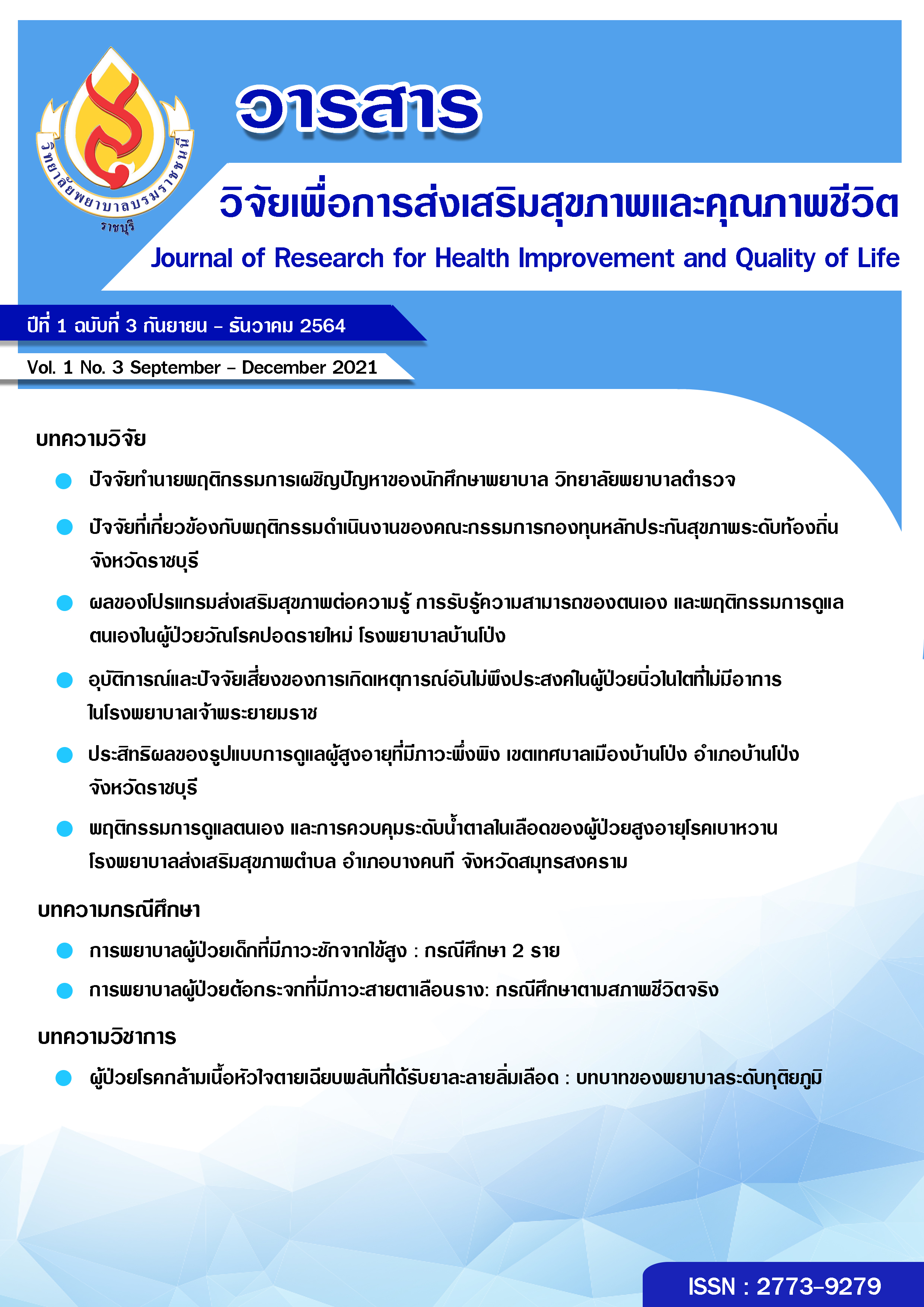อุบัติการณ์และปัจจัยเสี่ยงของการเกิดเหตุการณ์อันไม่พึงประสงค์ในผู้ป่วยนิ่วในไตที่ไม่มีอาการในโรงพยาบาลเจ้าพระยายมราช
คำสำคัญ:
นิ่วในไตที่ไม่มีอาการ, ภาวะแทรกซ้อน, นิ่วในระบบปัสสาวะ, อุบัติการณ์บทคัดย่อ
การศึกษาย้อนหลังจากเหตุไปหาผลครั้งนี้มีวัตถุประสงค์เพื่อศึกษาอุบัติการณ์และปัจจัยที่เกี่ยวข้องกับการเกิดเหตุการณ์อันไม่พึงประสงค์ของผู้ป่วยนิ่วในไตที่ไม่มีอาการ ในโรงพยาบาลเจ้าพระยายมราช ตัวอย่างเป็นเวชระเบียนของผู้ป่วยที่ตรวจพบเม็ดเลือดแดงในปัสสาวะ จากการตรวจปัสสาวะที่เข้ารับการตรวจรักษาที่หน่วยศัลยกรรมทางเดินปัสสาวะ โรงพยาบาลเจ้าพระยายมราช ระหว่าง พ.ศ. 2560-2563 จำนวน 163 ฉบับ กำหนดขนาดตัวอย่างด้วยการใช้สูตร Infinite population proportion เครื่องมือที่ใช้ในการวิจัยเป็นแบบบันทึกเหตุการณ์อันไม่พึงประสงค์ของผู้ป่วยนิ่วในไตที่ไม่มีอาการ ได้แก่ อาการปวด ติดเชื้อระบบปัสสาวะ ไตวายจากนิ่วอุดกั้นระบบปัสสาวะ และการเข้ารับการผ่าตัดจากการเกิดภาวะแทรกซ้อนของนิ่ว วิเคราะห์ข้อมูลโดยใช้สถิติพรรณนา การทดสอบไคสแควร์ การทดสอบค่าที และการวิเคราะห์การถดถอยโลจีสติก ผลการศึกษา พบว่า
อุบัติการณ์การเกิดเหตุการณ์อันไม่พึงประสงค์ จำนวน 36 ราย (ร้อยละ 22.1) โดยตำแหน่งที่พบนิ่ว คือ บริเวณขั้วบน (p= 0.007) หรือขั้วกลาง (p= 0.021) ของไต และเป็นปัจจัยที่สัมพันธ์กับการเกิดเหตุการณ์อันไม่พึงประสงค์ของผู้ป่วยนิ่วในไตที่ไม่แสดงอาการ
ดังนั้นผู้ป่วยที่พบนิ่วในไตโดยที่ยังไม่แสดงอาการ ส่วนมากสามารถใช้การติดตามอาการอย่างต่อเนื่องได้โดยที่ไม่ต้องเข้ารับการรักษาด้วยการผ่าตัดที่อาจส่งผลให้เกิดภาวะแทรกซ้อนได้
เอกสารอ้างอิง
Alexander, R. T., Hemmelgarn, B. R., Wiebe, N., Bello, A., Samuel, S., Klarenbach, S. W., ... & Tonelli, M. (2014). Kidney stones and cardiovascular events: a cohort study. Clinical Journal of the American Society of Nephrology, 9(3), 506-512.
Boyce, C. J., Pickhardt, P. J., Lawrence, E. M., Kim, D. H., & Bruce, R. J. (2010). Prevalence of urolithiasis in asymptomatic adults: objective determination using low dose noncontrast computerized tomography. The Journal of urology, 183(3), 1017-1021.
Cappuccio, F.P., Strazzullo, P., & Mancini, M. (1990). Kidney stones and hypertension: population based study of an independent clinical association. British Medical Journal, 300, 1234-1236.
Darrad, M. P., Yallappa, S., Metcalfe, J., & Subramonian, K. (2018). The natural history of asymptomatic calyceal stones. BJU international, 122(2), 263-269.
Dropkin, B. M., Moses, R. A., Sharma, D., & Pais, V. M. (2015). The natural history of nonobstructing asymptomatic renal stones managed with active surveillance. The Journal of urology, 193(4), 1265-1269.
El-Zoghby, Z. M., Lieske, J. C., Foley, R. N., Bergstralh, E. J., Li, X., Melton, L. J., ... & Rule, A. D. (2012). Urolithiasis and the risk of ESRD. Clinical Journal of the American Society of Nephrology, 7(9), 1409-1415.
Ferraro, P. M., Curhan, G. C., D’Addessi, A., & Gambaro, G. (2017). Risk of recurrence of idiopathic calcium kidney stones: analysis of data from the literature. Journal of nephrology, 30, 227-233.
Fink, H. A., Wilt, T. J., Eidman, K. E., Garimella, P. S., MacDonald, R., Rutks, I. R., .. & Monga, M. (2013). Medical management to prevent recurrent nephrolithiasis in adults: a systematic review for an American College of Physicians Clinical Guideline. Annals of internal medicine, 158(7), 535-543.
Ganesan, V., De, S., Greene, D., Torricelli, F. C. M., & Monga, M. (2017). Accuracy of ultrasonography for renal stone detection and size determination: is it good enough for management decisions?. BJU international, 119(3), 464-469.
Keddis, M.T., & Rule, A.D. (2013). Nephrolithiasis and loss of kidney function. Current Opinion in Nephrology and Hypertension, 22, 390-396.
Li, X., Zhu, W., Lam, W., Yue, Y., Duan, H., & Zeng, G. (2019). Outcomes of long‐term follow‐up of asymptomatic renal stones and prediction of stone‐related events. British Journal of Urology International, 123(3), 485-492.
Lorenz, E. C., Lieske, J. C., Vrtiska, T. J., Krambeck, A. E., Li, X., Bergstralh, E. J., ... & Rule, A. D. (2011). Clinical characteristics of potential kidney donors with asymptomatic kidney stones. Nephrology Dialysis Transplantation, 26(8), 2695-2700.
Quhal, F., & Seitz, C. (2021). Guideline of the guidelines: urolithiasis. Current opinion in urology, 31(2), 125-129.
Rule, A.D., Krambeck, A.E., & Lieske, J.C. (2011). Chronic kidney disease in kidney stone formers. Clinical Journal of the American Society of Nephrology, 6, 2069-2075.
Scales Jr, C. D., Smith, A. C., Hanley, J. M., Saigal, C. S., & Urologic Diseases in America Project. (2012). Prevalence of kidney stones in the United States. European urology, 62(1), 160-165.
Seseke, S., Rudolph, R., & Rebmann, U. (2011). Asymptomatic renal stones: Do they really exist? Aktuelle Urologie, 42, 374-377.
Shoag, J., Halpern, J., Goldfarb, D. S., & Eisner, B. H. (2014). Risk of chronic and end stage
kidney disease in patients with nephrolithiasis. The Journal of urology, 192(5), 1440-1445. Strazzullo, P., Barba, G., Vuotto, P., Farinaro, E., Siani, A., Nunziata, V., ... & Cappuccio, F. P. (2001). Past history of nephrolithiasis and incidence of hypertension in men: a reappraisal based on the results of the Olivetti Prospective Heart Study. Nephrology Dialysis Transplantation, 16(11), 2232-2235.
ดาวน์โหลด
เผยแพร่แล้ว
ฉบับ
ประเภทบทความ
สัญญาอนุญาต
ลิขสิทธิ์ (c) 2021 วิทยาลัยพยาบาลบรมราชชนนี ราชบุรี

อนุญาตภายใต้เงื่อนไข Creative Commons Attribution-NonCommercial-NoDerivatives 4.0 International License.
บทความทีตีพิมพ์ในวารสารนี้ถือว่าเป็นลิขสิทธิ์ของวิทยาลัยพยาบาลบรมราชชนนี ราชบุรี และผลงานวิชาการหรือวิจัยของคณะผู้เขียน ไม่ใช่ความคิดเห็นของบรรณาธิการหรือผู้จัดทํา




